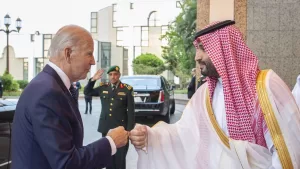The United States’ chaotic withdrawal from Afghanistan has dented the credibility of the trans-Atlantic relationship and dealt a body blow to the NATO. These developments add to the already existing frustration in Washington that the European allies disfavour its confrontational Indo-Pacific Strategy. Europe regards China as an economic competitor and ‘systemic rival’, but prefers the path of engagement and dialogue.
While a break-up of the trans-Atlantic alliance is inconceivable, the centrifugal forces at play are unprecedented. The China-focused policy of the US is contributing to the unraveling of the Western alliance system. The Quad, which the Trump administration resuscitated to counter the challenges posed by China’s rise, has no European content.
The West Asian Quad (Quad-2), comprising the US, Israel, the UAE and India, which the Biden Administration unveiled two weeks ago, also follows the same format — the US networking with regional partners.
Both Quad-1 and Quad-2 have China in their crosshairs. Both are conceived as ‘coalitions of the willing’. Both formats have sea power as the dominant paradigm. Both are anchored on the control of the chokepoints in sea lanes — the Malacca Straits and the Bab-el-Mandeb Strait respectively. The Malacca Straits provide sea passage to the Indian Ocean from the South China Sea; the Bab el-Mandeb Strait connects the Arabian Sea and the Gulf of Aden to the Red Sea and the Suez Canal.
Now, it is on the Yemeni island of Socotra, which overlooks the strategic Bab al-Mandab Strait, that the UAE and Israel have created an intelligence gathering base. The UAE has deployed hundreds of troops on the strategic island since May 2018, disregarding the protest by the Yemeni government. The base can provide critical security services to the US regarding the Chinese economic activity, especially its trade with Europe, and the movements of the Chinese Navy.
The island of Socotra is known as the “Jewel of the Gulf of Aden” and is the largest of the archipelago of the same name, which consists of four islands and two islets sitting at a strategic location in the Indian Ocean, off the Horn of Africa’s coast, in the Arabian Sea. Most exports of oil and natural gas from the Persian Gulf that transit the Suez Canal and the Suez-Mediterranean Pipeline pass through the Bab al-Mandeb Strait.
For years, the UAE has been seeking to annex the island, and the collapse of the Yemeni state due to years of instability has paved the way for this takeover.
An interesting sideshow here is the UAE’s diplomatic, military and economic competition with Saudi Arabia in Yemen. For the UAE, controlling Socotra means strengthening its commercial and military projection in the Indian Ocean, thus emphasising its rising inter-regional prestige.
On the other hand, Saudi Arabia’s interest lies in curbing the Emirati influence on the island thereby reaffirming Riyadh’s pre-eminence in Yemen as well as in the balance of power in the Gulf region.
Security analysts estimate that the spy base in Socotra will also be used to monitor Pakistan, especially Gwadar Port. Clearly, the Quad-2 impacts the power dynamic in the region.
The Israeli media has reported that Socotra Island is “attracting a lot of attention from the Israeli security services.” It is entirely conceivable that in reality, the base is an US-Israeli project. The US has been making efforts to derail the China-Pakistan Economic Corridor which connects Gwadar to Kashgar in Xinjiang.
The Israeli military intelligence website Debka File reported in May that the UAE is also building a new air base on a volcanic island off Yemen called Perim Island, which will give the “means of controlling oil tanker and commercial shipping through the Red Sea’s southern chokepoint and up to the Suez Canal.”
The well-known Middle East expert at the Brookings Institution, Bruce Riedel wrote in an analysis in May that Saudi Arabia and the UAE have “entrenched their hold on strategic parts” of Yemen and are “unlikely to give up their gains without significant international pressure.”
Riedel wrote that the Saudis occupied the province of al-Mahrah, Yemen’s second largest, which borders on Oman and has 20 bases and outposts in the province now. Al-Mahrah port gives Saudi Arabia direct access to the Indian Ocean. According to Riedel, Riyadh plans to build an oil pipeline from Saudi Arabia’s Eastern Province through al-Mahrah to the sea which would ease Saudi dependence on the Straits of Hormuz for exporting oil.
On the other hand, the UAE’s focus is on Yemen’s strategic islands. Riedel wrote: “The United States should not be a party to the dismemberment of Yemen. It is not too early to quietly put down a marker that if a cease-fire is arranged in Yemen, the Saudis and Emiratis will need to evacuate al-Mahrah, Mayun, and Socotra, and return control to the Yemenis.”
Indeed, given such high stakes affecting the US’ Indo-Pacific strategy to contain China, it is improbable that Washington will ask the UAE, Israel and Saudi Arabia to leave Yemen alone.
Put simply, Quad-1 and Quad-2 are joined at the hips. Given the Quad-2’s agenda to monitor China and Pakistan, Washington has thoughtfully invited India to join. Of course, Israel and the UAE also have very friendly ties with India.
However, a few caveats must be added. First, it is one hundred percent certain that whatever UAE and Israel do in Yemen and the Arabian Sea will have an Iran angle to it. In fact, Iran is under no illusions on that score. The Tehran Times recently featured an interview with Yemen’s ambassador to Iran. According to the ambassador, it is an Anglo-American condominium that is at work in Yemen and it is only with US backing that the UAE and Saudi Arabia have pursued such an interventionist policy.
The conflict in Yemen has been one of the most brutal wars in the post-Cold War era. Why should India have Yemeni blood on its hands? Equally, Quad-2 has an anti-Iran dimension to it. India-Iran ties can never be the same gain if Delhi teams up with the US and Israel, UAE in Iran’s immediate neighbourhood.
Third, Quad-2 is a major step in boosting the US-Indian quasi-alliance. As the latest developments in Sudan show, a nasty geopolitical struggle is erupting for control of the Horn of Africa and the Red Sea. For Israel, the great game provides ideal setting to get embedded in Arab politics. But India needs to be circumspect.
It is not in India’s interests to needlessly annoy a host of countries in the region and from outside the region such as Turkey, Iran, Qatar, China, Pakistan — and even Russia. The bottomline is that the government must explain how India benefits out of this joyride in Quad-2.
(Ambassador M.K. Bhadrakumar served the Indian Foreign Service for more than 29 years. Courtesy: Indianpunchline.)




